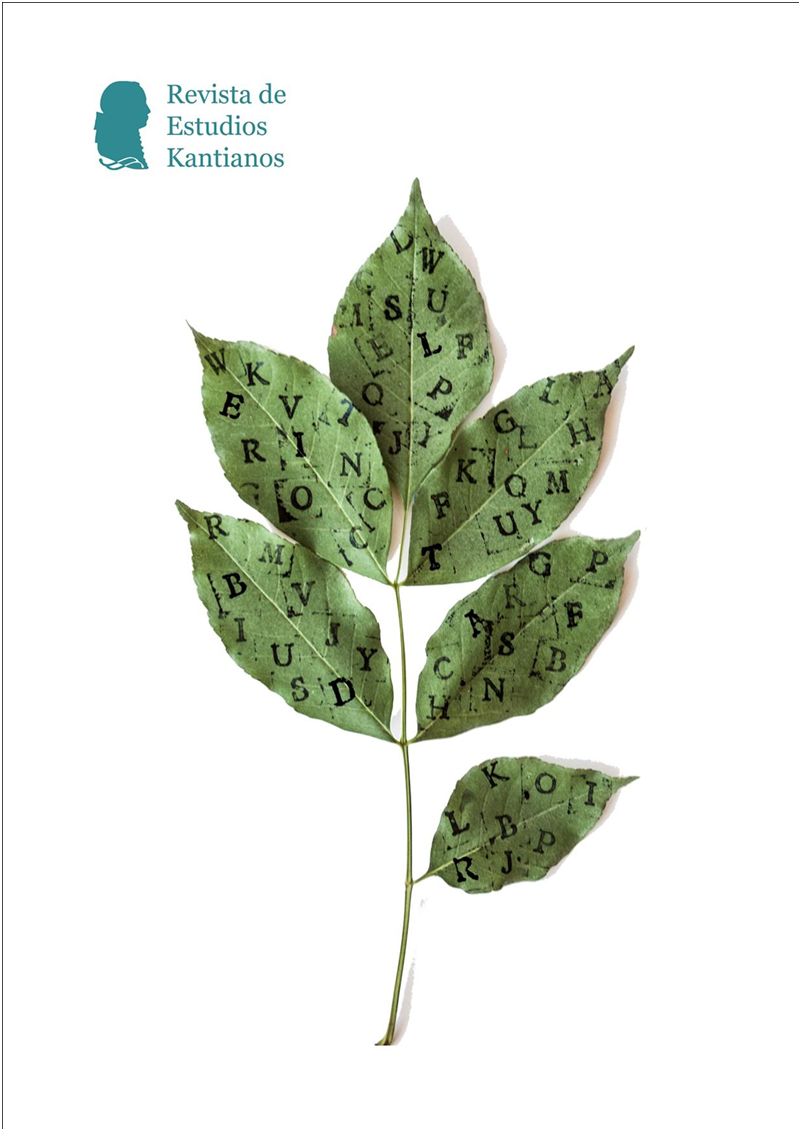El carácter sintético-originario de la intuición formal del espacio en Kant
DOI:
https://doi.org/10.7203/REK.9.1.27656Keywords:
espacio, intuición formal, unidad sintética, apercepción Abstract
Abstract
El espacio puede ser concebido como forma de la intuición y como intuición formal. En el primer caso, es considerado como una de las formas a través de las cuales nuestra sensibilidad es capaz de recibir representaciones. En el segundo caso, el espacio es considerado como una representación unitaria que contiene una multiplicidad dentro de sí. En este trabajo, se sostiene que la unidad de la intuición formal del espacio es el resultado de una síntesis categorial que remite a la unidad sintética de la apercepción, aplicada a una multiplicidad sensible que es dada según la forma del espacio.
 Downloads
Downloads
 References
References
Allais, L. (2009). “Kant, Non-Conceptual Content and the Representation of Space”. Journal of the History of Philosophy, vol. 47, no. 3, 383-413.
Allison. H. (1983). Kant’s Transcendental Idealism: An Interpretation and Defense. New Haven, Yale University Press.
Caimi, M. (1996). “About the argumentative structure of the transcendental aesthetic”. Studi Kantiani, Vol. 9, 27-46.
de Sá Pereira, R. (2020). “Cassirer and Kant on the Unity of Space and the Role of Imagination”. Kant Yearbook, 12 (1), 115-135.
Cohen, H. (1907). Kommentar zu Immanuel Kants Kritik der reinen Vernunft. Lepzig, Meiner.
—--------- (1987). Kants Theorie der Erfahrung. Vol.1.3 (1871 edition), Hildesheim, Olms.
Dufour, E. (2003). “Remarques sur la note du paragraphe 26 de l’Analytique transcendentale: Les interpretations de Cohen et de Heidegger”. Kant-Studien, 94, no. 1, 69-79.
Falkenstein, L. (1995). Kant’s Intuitionism: A Commentary on the Transcendental Aesthetic. Toronto, Toronto University Press.
Fichant, M. (1997). “L’espace est representé comme un grandeur infinie donée: La radicalité de l’esthétique”. Philosophie, 56, 20-48.
—----------- (2004). “Espace esthétique et espace géométrique chez Kant”. Revue de métaphysique et de morale, 44 (4), 530-50.
Friedman, M. (2020). “Space and geometry in the B Deduction”. En C. Posy (ed.), Kant’s Philosophy of Mathematics (pp. 200-228). Cambridge University Press.
—-------------- (2012). “Kant on geometry and spatial intuition”. Synthese, 186, 231-255.
Grüne, S. (2016). “Sensible Synthesis and the Intuition of Space”. En D. Schulting (ed.), Kantian Nonconceptualism (pp. 81-98). London, Palgrave Macmillan.
Guyer, P. (2018). “The Infinite Given Magnitude and Other Myths About Space and Time”. En I. Agostini et al. (eds.), Infinity in Early Modern Philosophy (pp. 181-204). Springer Verlag.
Heidegger, M. (1991). Kant und das Problem der Metaphysik. Gesamtausgabe, II. Abteilung, Bd. 25. Frankfurt a/M, Klostermann.
—---------------- (1995). Phänomenologische Interpretation von Kants Kritik der reinen Vernunft. Gesamtausgabe, II. Abteilung, Bd. 25. Frankfurt a/M, Klostermann.
Kant, I. (2022) [1781/1787]. Crítica de la razón pura. Traducción, notas e introducción: Mario Caimi. Buenos Aires, Colihue.
Land, T. (2016). “Moderate Conceptualism and Spatial Representation”. En D. Schulting (ed.), Kantian Nonconceptualism (pp. 145-70). London, Palgrave Macmillan.
Lazos, E. (2018). “Unidad del espacio, mereología y geometría desde la estética trascendental”. Revista de Estudios Kantianos, 3 (1), 46-68.
Longuenesse, B. (2005). “Synthesis and givenness”. En B. Longuenesse, Kant on the Human Standpoint (pp. 64-78). Cambridge University Press.
—------------------- (2000). “Point of View of Man or Knowledge of God”. En S. Sedgwick (ed.), The Reception of Kant’s Critical Philosophy: Fichte, Schelling and Hegel (pp. 253-282). Cambridge, Cambridge University Press.
—------------------- (1998). Kant and the Capacity to Judge. Princeton, Princeton University Press.
McLear, C. (2015). “Two Kinds of Unity in the Critique of Pure Reason”. Journal of the History of Philosophy, 53 (1), 79-110.
Melnick, A. (1973). Kant’s Analogies of Experience. Chicago, Chicago University Press.
Messina, J. (2014). “Kant on the Unity of Space and the Synthetic Unity of Apperception”. Kant-Studien, 105 (1), 5-40.
Nakano, H. (2008). “La distinción kantiana entre forma de la intuición y la intuición formal”. Signos filosóficos, vol. X, núm. 19, 69-94.
Onof, C. y Schulting, D. (2015). “Space as Form of Intuition and as Formal Intuition: On the Note to B160 in Kant’s Critique of Pure Reason”. Philosophical Review, 124 (1), 1-58.
Raysmith, T. (2022). “Kant´s Original Space and Time as Mere Grounds for Possibilities”. Kantian Review, 27, 23-42.
Roche, A. (2018). “Kant’s Transcendental Deduction and the Unity of Space and Time”. Kantian Review, 23 (1), 41-64.
Rosefeldt, T. (2022). “Kant on Decomposing Synthesis and the Intuition of Infinite Space”. Philosophers’ Imprint, 22 (1). doi: https://doi.org/10.3998/phimp.2122
Shaddock, J. (2017). “Kant’s Conceptualism: A New Reading of the Transcendental Deduction”. Pacific Philosophical Quarterly, 99 (3), 464-488.
Waxman, W. (1991). Kant’s Model of the Mind: A New Interpretation of Transcendental Idealism. Oxford, Oxford University Press.
Williams, J. (2017). “Kant on the original synthesis of understanding and sensibility”. British Journal for the History of Philosophy, 26 (1), 1-21.
Downloads
Published
How to Cite
-
Abstract141
-
PDF (Español)72
Issue
Section
License
![]()
The authors who publish in this journal agree with the following terms:
- The authors retain their copyright and guarantee to the journal the right to be the first to publish the work and to license it under a Creative Commons Attribution License that allows others to share the work with an acknowledgement of its authorship and the initial publication in this journal.
- Authors may separately establish additional agreements for non-exclusive distribution of the version of the work published in the journal (for example, placing it in an institutional repository or publishing it in a book), with acknowledgement of its initial publication in this journal.
- Authors are allowed and encouraged to disseminate their work electronically (e.g., in institutional repositories or on their own website) before and during the submission process, as this can lead to productive exchanges as well as earlier and greater citation of published work (see The Effect of Open Access).








